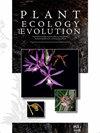Reproductive biology and flower-visitor interactions of two bromeliad species from the Brazilian Atlantic Forest
IF 1.1
4区 生物学
Q3 PLANT SCIENCES
引用次数: 0
Abstract
Background and aims – The Bromeliaceae family has great importance in the maintenance of neotropical communities. In the Brazilian Atlantic Forest, bromeliads are among the major groups responsible for maintaining the local flora and fauna and participate in important ecological interactions with insects, anurans, and hummingbirds. This work reports on aspects of the reproductive biology and the interactions between two endemic bromeliad species from the Atlantic Forest (Aechmea bruggeri and Quesnelia indecora) and their floral visitors to assess the impact of these relationships on the reproductive success and conservation of these plants.Material and methods – Reproductive phenology, floral biology, pollination experiments, and the reproductive success of both species were investigated. To determine the floral visitors, we made direct observations on flowers and collected floral visitors that could not be identified in the field.Key results – Aechmea bruggeri and Quesnelia indecora presented the individual and population flowering phenological pattern classified as annual with intermediate duration. The species are partially and totally self-incompatible, respectively. Both species presented a varied visitation guild, and although Q. indecora presented flowers with ornitofilous characteristics, no hummingbirds were recorded for this species. The hummingbird Thalurania glaucopis was the main visitor for Aechmea bruggeri and the bee Trigona cf. braueri was the main visitor for Quesnelia indecora. Nectar thieving by lepidopterans was observed for both species. Pollen robbing by beetles and nectar robbing by bees were registered for Aechmea bruggeri and Quesnelia indecora, respectively. Fruit and seed set of both species were highly affected by herbivory, which may negatively affect their reproductive success.Conclusion – Our work highlights the important role of bromeliads in neotropical communities, showing how floral visitors and plants interact by participating in maintaining biological diversity in the studied forest remnant.巴西大西洋森林两种凤梨属植物的生殖生物学及花-客相互作用
背景与目的-凤梨科植物在维持新热带群落中具有重要意义。在巴西大西洋森林,凤梨科植物是负责维护当地动植物的主要群体之一,并与昆虫、无尾动物和蜂鸟进行重要的生态互动。本文报道了大西洋森林两种特有凤梨科植物(Aechmea bruggeri和Quesnelia indecora)及其访花植物之间的生殖生物学和相互作用,以评估这些关系对这些植物繁殖成功和保护的影响。材料和方法:研究了两种植物的生殖物候学、花生物学、授粉实验和繁殖成功率。为了确定访花者,我们对花进行了直接观察,并收集了在野外无法识别的访花者。重点结果:布氏杜鹃花和斑点杜鹃花的个体和种群开花物候模式均为一年生,历时中等。这两个物种分别是部分和完全自交不亲和的。两种物种均呈现出不同的访花方式,尽管其花具有鸟丝特征,但未见蜂鸟的记录。蜂鸟是布鲁氏芽孢杆菌的主要寄主,蜜蜂是斑点线虫的主要寄主。鳞翅目昆虫在这两个物种中都有偷食花蜜的行为。布鲁氏灰衣螨(aecmea bruggeri)和灰衣螨(Quesnelia indecora)分别有甲虫抢花粉和蜜蜂抢花蜜现象。两种植物的果实和种子均受食草性影响较大,这可能对其繁殖成功率产生不利影响。结论:我们的工作突出了凤梨花在新热带群落中的重要作用,展示了花卉访客和植物如何通过参与维持所研究森林遗迹的生物多样性而相互作用。
本文章由计算机程序翻译,如有差异,请以英文原文为准。
求助全文
约1分钟内获得全文
求助全文
来源期刊

Plant Ecology and Evolution
PLANT SCIENCES-
CiteScore
2.20
自引率
9.10%
发文量
27
审稿时长
>12 weeks
期刊介绍:
Plant Ecology and Evolution is an international peer-reviewed journal devoted to ecology, phylogenetics and systematics of all ‘plant’ groups in the traditional sense (including algae, cyanobacteria, fungi, myxomycetes), also covering related fields.
The journal is published by Meise Botanic Garden and the Royal Botanical Society of Belgium.
 求助内容:
求助内容: 应助结果提醒方式:
应助结果提醒方式:


